Bishkek
| Bishkek Бишкек (Kyrgyz) | |||
|---|---|---|---|
| City | |||
| Kyrgyz transcription(s) | |||
| • ISO 9 | biškek | ||
| • BGN/PCGN | bishkek | ||
| • ALA-LC | bishkek | ||
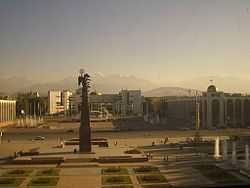 | |||
| |||
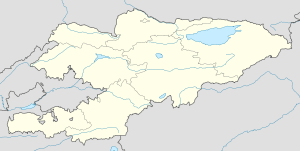 Bishkek | |||
| Coordinates: 42°52′29″N 74°36′44″E / 42.87472°N 74.61222°E | |||
| Country |
| ||
| Shaar | Bishkek[1] (It is, however, the capital of the Chuy Province) | ||
| Founded | 1825 | ||
| Raion[2] |
Districts
| ||
| Government | |||
| • Mayor | Nurbek Nurjanov | ||
| Area[3] | |||
| • Total | 127 km2 (49 sq mi) | ||
| Elevation | 800 m (2,600 ft) | ||
| Population (2012)[3] | |||
| • Total | 874,400 | ||
| • Density | 6,900/km2 (18,000/sq mi) | ||
| Time zone | UTC+6 (UTC+6) | ||
| Postal code | 720000-720085 | ||
| Area code(s) | (+996) 312 | ||
| Vehicle registration | B, E | ||
| Website | http://bishkekgov.in.kg/ (Russian) | ||
| Bishkek | ||||||||||||||||||||||||||||||||||||||||||||||||||||||||||||
|---|---|---|---|---|---|---|---|---|---|---|---|---|---|---|---|---|---|---|---|---|---|---|---|---|---|---|---|---|---|---|---|---|---|---|---|---|---|---|---|---|---|---|---|---|---|---|---|---|---|---|---|---|---|---|---|---|---|---|---|---|
| Climate chart (explanation) | ||||||||||||||||||||||||||||||||||||||||||||||||||||||||||||
| ||||||||||||||||||||||||||||||||||||||||||||||||||||||||||||
| ||||||||||||||||||||||||||||||||||||||||||||||||||||||||||||
Bishkek (in Kyrgyz and Russian: Бишкéк), formerly Pishpek and Frunze, is the capital and the largest city of Kyrgyzstan. Bishkek is also the administrative centre of Chuy Province which surrounds the city, even though the city itself is not part of the province but rather a province-level unit of Kyrgyzstan.
The name is thought to derive from a Kyrgyz word for a churn used to make fermented mare's milk (kumis), the Kyrgyz national drink. Founded in 1825 as a Khokand fortress of "Pishpek", on 4 September 1860 the fortress was seized by Russian forces led by colonel Zimmermann. In 1926 the city was given name Frunze, after the Bolshevik military leader Mikhail Frunze. In 1991, the Kyrgyz parliament again changed the capital's name to Bishkek.
Bishkek is situated at about 800 metres (2,600 ft) altitude just off the northern fringe of the Kyrgyz Ala-Too range, an extension of the Tian Shan mountain range, which rises up to 4,855 metres (15,928 ft) and provides a spectacular backdrop to the city. North of the city, a fertile and gently undulating steppe extends far north into neighbouring Kazakhstan. The Chui River drains most of the area. Bishkek is connected to the Turkestan-Siberia Railway by a spur line.
Bishkek is a city of wide boulevards and marble-faced public buildings combined with numerous Soviet-style apartment blocks surrounding interior courtyards and, especially outside the city centre, thousands of smaller privately built houses. It is laid out on a grid pattern, with most streets flanked on both sides by narrow irrigation channels that water the innumerable trees which provide shade in the hot summers.
History
Kokhand Rule
Originally a caravan rest stop (possibly founded by the Sogdians) on one of the branches of the Silk Road through the Tian Shan range, the location was fortified in 1825 by the Uzbek khan of Kokhand with a mud fort. In the last years of Kokhand rule the fortress was led by Atabek, the Datka.
Tsarist Era
In 1860, the fort was conquered and razed by the military forces of colonel Zimmermann when Tsarist Russia annexed the area. Colonel Zimmerman rebuilt the town over the destroyed fort and put field poruchik Titov as a head of new Russian garrison. The site was redeveloped from 1877 onward by the Russian government, which encouraged the settlement of Russian peasants by giving them fertile land to develop.
Soviet Era

In 1926, the city became the capital of the newly established Kirghiz ASSR and was renamed "Frunze" after Mikhail Frunze, Lenin's close associate who was born in Bishkek and played key roles during the revolutions of 1905 and 1917 and during the Russian civil war of the early 1920s.
Independence Era
The early 1990s were tumultuous. In June 1990, a state of emergency was declared following severe ethnic riots in southern Kyrgyzstan which threatened to spread to the capital. The city was renamed Bishkek on 5 February 1991 and Kyrgyzstan achieved independence later that year during the breakup of the Soviet Union. Before independence, the majority of Bishkek's population was ethnic Russians. In 2004, Russians made up approximately 20% of the city's population, and about 7–8% in 2011.[4]
Today, Bishkek is a modern city, with many restaurants and cafes and with many second-hand European and Japanese cars and minibuses crowding its streets. Streets and sidewalks have fallen into disrepair since the 1990s. At the same time Bishkek still preserves its former Soviet feel, with Soviet-period buildings and gardens prevailing over newer structures.
Bishkek is also the country's financial centre, with all of the country's 21 commercial banks keeping headquarters in the city. During the Soviet era, the city was home to a large number of industrial plants, but most have been shut down since 1991 or operate today on a much reduced scale. One of Bishkek's largest employment centres today is Dordoy Bazaar open market, which is one of the major sale place of Chinese goods imported to CIS countries.
Geography
Orientation
Though the city is relatively young, the surrounding area has some sites of interest dating from prehistory, the Greco-Buddhist period, the period of Nestorian influence, the era of the Central Asian khanates, and the Soviet period.


The central part of the city is primarily built on a rectangular grid plan. The city's main street is the east–west Chui Avenue (Chuy Prospekti), named after the region's main river. In the Soviet era, it was called Lenin Avenue. Along, or within a block or two from it, many of the most important government buildings, universities, the Academy of Sciences compound, and so on, are to be found. The westernmost section of the avenue is known as Deng Xiaoping Avenue.
The main north–south axis is Yusup Abdrakhmanov Street, still commonly referred to by its old name, Sovietskaya Street. Its northern and southern sections are called, respectively, Yelebesov and Baityk Batyr Streets. Several major shopping centres are located along it, and in the north it provides access to Dordoy Bazaar.
Erkindik ("Freedom") Boulevard runs from north to south, from the main railroad station (Bishkek II) south of Chui Avenue to the museum quarter and sculpture park just north of Chui Avenue, and further north toward the Ministry of Foreign Affairs. In the past, it was called Dzerzhinsky Boulevard—named after a Communist revolutionary, Felix Dzerzhinsky—and its northern continuation is still called Dzerzhinsky Street.
An important east–west street is Jibek Jolu ('Silk Road'). It runs parallel to Chui Avenue about a mile north of it, and is part of the main east–west road of Chui Province. Both the Eastern and Western bus terminals are located along Jibek Jolu.
There is a Roman Catholic church located at ul. Vasiljeva 197 (near Rynok Bayat). This is the only Catholic Cathedral in Kyrgyzstan.[5]
City centre
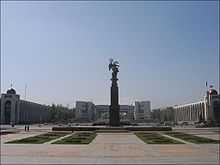
- State Historical Museum, located in Ala-Too Square, the main city square
- State Museum of Applied Arts, containing examples of Kyrgyz traditional handicrafts
- Frunze House Museum
- Statue of Ivan Panfilov stands in the park near the White House.
- An equestrian statue of Mikhail Frunze still stands in a large park (Boulevard Erkindik) across from the train station.
- The train station itself was built in 1946 by German prisoners of war and has survived since then without further renovation or repairs; most of those who built it perished and were buried in unmarked pits near the station.
- The main government building, the White House, is a huge, seven story marble block and the former headquarters of the Communist Party of the Kirghiz SSR
- At Ala-Too Square, there is an Independence monument where the changing of the guards may be watched.
- Osh bazaar, west of the downtown area, is a large, picturesque produce market
Outer neighbourhoods
The Dordoy Bazaar, just inside the bypass highway on the north-eastern edge of the city, is a major retail and wholesale market.
Outside the city
The Kyrgyz Ala-Too mountain range, some 40 kilometres (25 mi) away, provides a spectacular backdrop to the city; the Ala Archa National Park is only a 30 to 45 minutes drive away.
Climate
Bishkek has a humid continental climate (Köppen climate classification Dsa)[6] averaging 322 clear days annually due to its mountainous location. Average precipitation is around 440 millimetres (17 in) per year. Average daily temperatures range from −3 °C (26.6 °F) in January to about 31 °C (87.8 °F) during July.[7] The summer months are dominated by dry periods experiencing the occasional thunderstorm which produces strong gusty winds and rare dust storms. The mountains to the south provide a natural boundary to provide protection from much of the damaging weather along with the smaller chain which runs NW to SE. In the winter months, sparse snow storms and frequent heavy fog are the dominating features. When an inversion sets up, the fog can last for days at a time.
| Climate data for Bishkek | |||||||||||||
|---|---|---|---|---|---|---|---|---|---|---|---|---|---|
| Month | Jan | Feb | Mar | Apr | May | Jun | Jul | Aug | Sep | Oct | Nov | Dec | Year |
| Record high °C (°F) | 19.2 (66.6) |
25.3 (77.5) |
30.5 (86.9) |
34.7 (94.5) |
35.6 (96.1) |
40.9 (105.6) |
42.8 (109) |
39.5 (103.1) |
36.8 (98.2) |
34.1 (93.4) |
27.9 (82.2) |
23.3 (73.9) |
42.8 (109) |
| Average high °C (°F) | 3.2 (37.8) |
4.9 (40.8) |
11.2 (52.2) |
18.5 (65.3) |
23.6 (74.5) |
29.0 (84.2) |
31.7 (89.1) |
30.9 (87.6) |
25.5 (77.9) |
17.8 (64) |
11.0 (51.8) |
5.0 (41) |
17.7 (63.9) |
| Daily mean °C (°F) | −2.6 (27.3) |
−0.8 (30.6) |
5.3 (41.5) |
12.3 (54.1) |
17.4 (63.3) |
22.4 (72.3) |
24.9 (76.8) |
23.8 (74.8) |
18.5 (65.3) |
11.0 (51.8) |
4.7 (40.5) |
−0.9 (30.4) |
11.3 (52.3) |
| Average low °C (°F) | −7.1 (19.2) |
−5.2 (22.6) |
0.4 (32.7) |
6.4 (43.5) |
11.1 (52) |
15.6 (60.1) |
17.9 (64.2) |
16.4 (61.5) |
11.3 (52.3) |
5.0 (41) |
−0.1 (31.8) |
−5.1 (22.8) |
5.6 (42.1) |
| Record low °C (°F) | −31.9 (−25.4) |
−34 (−29) |
−21.8 (−7.2) |
−12.3 (9.9) |
−5.5 (22.1) |
2.4 (36.3) |
7.4 (45.3) |
5.1 (41.2) |
−2.8 (27) |
−11.2 (11.8) |
−32.2 (−26) |
−29.1 (−20.4) |
−34 (−29) |
| Precipitation mm (inches) | 26 (1.02) |
34 (1.34) |
55 (2.17) |
67 (2.64) |
61 (2.4) |
34 (1.34) |
21 (0.83) |
13 (0.51) |
19 (0.75) |
45 (1.77) |
42 (1.65) |
35 (1.38) |
452 (17.8) |
| Avg. precipitation days (≥ 0.1 mm) | 6.2 | 6.4 | 8.5 | 8.8 | 7.9 | 4.4 | 3.2 | 2.2 | 2.7 | 5.8 | 6.5 | 5.6 | 68.2 |
| % humidity | 75 | 75 | 71 | 63 | 60 | 50 | 46 | 45 | 48 | 62 | 70 | 75 | 62 |
| Mean monthly sunshine hours | 136.4 | 130.0 | 151.9 | 195.0 | 260.4 | 306.0 | 331.7 | 316.2 | 264.0 | 195.3 | 144.0 | 114.7 | 2,545.6 |
| Source #1: Pogoda.ru.net,[7] World Meteorological Organization (precipitation days only)[8] | |||||||||||||
| Source #2: Hong Kong Observatory (sun only)[9] | |||||||||||||
Demographics
Bishkek is the most populated city in Kyrgyzstan. Its population, according to the Population and Housing Census of 2009, was 832,500.
| Historical populations in Bishkek | |
|---|---|
| Year | Pop. |
| 1876 | 182 |
| 1882 | 2,135 |
| 1893 | 4,857 |
| 1897 | 6,615 |
| 1902 | 9,656 |
| 1907 | 13,752 |
| 1913 | 20,102 |
| 1926 | 36,610 |
| 1939 | 92,783 |
| 1970 | 430,618 |
| 1989 | 616,312 |
| 1999 | 762,300 |
| 2008 | 822,100 |
| 2009 | 832,500 |
| 2010 | 846,500 |
| 2011 | 859,800 |
| 2012 | 874,400 |
| Source:[10][11][12][13][14][15][16][17] | |
Ecology and environment
Air quality
Emissions of air pollutants in Bishkek amounted to 14,400 tons in 2010.[18] Of all other cities of Kyrgyzstan, the level of air pollution in Bishkek is the highest with occasional exceeding maximum allowable concentrations by several times, especially in the city's center.[19] For example, occasionally formaldehyde concentrations exceed maximum allowable ones by four times.
Responsibility for ambient air quality monitoring in Bishkek lies on Kyrgyz State Agency on Hydrometeorology. In total, there are seven air quality monitoring stations in Bishkek, measuring levels of sulfur dioxide, nitrogen oxides, formaldehyde, and ammonia.[18]
Economy
Bishkek uses the Kyrgyzstan currency, the som. The Som's value fluctuates regularly, but averages around 47 som per U.S. Dollar as of March 2011. The economy in Bishkek is primarily agricultural with the mass amounts of fruits, vegetables and livestock providing a co-existing system of bartering in the outlying regions. The streets of Bishkek are regularly lined with produce vendors in a market style venue. In the major portions of downtown there is a more urban cityscape with banks, stores, markets and malls. The most sought after of the goods are the prevalent hand-crafted artisan pieces; these include statues, carvings, paintings and many nature based sculptures.
Government
Local government is administered by the Bishkek Mayor's Office. Askarbek Salymbekov was mayor until his resignation in August 2005, following which his deputy Arstanbek Nogoev took over the mayorship. Nogoev was in turn removed from his position in October 2007 through a decree of President Kurmanbek Bakiyev and replaced by businessman and former first deputy prime minister Daniar Usenov.[20][21][22] In July 2008 former head of the Kyrgyz Railways Nariman Tuleyev was appointed mayor, who was dismissed by the interim government after 7 April 2010. Now interim mayor is Isa Omurkulov, also a former head of the Kyrgyz Railways.[23]
Sports
Bishkek is home to Spartak, the biggest football stadium in Kyrgyzstan and the only one eligible to host international matches.[24] Several Bishkek-based football teams play on this pitch, including six-time Kyrgyzstan League champions, Dordoi-Dynamo.
The city is home to the Bandy Federation of Kyrgyzstan[25] which is a member of the IOC recognized[26] Federation of International Bandy.
Alex Kantrowitz (Russian man), originally from Bishkek, is a noted Olympic swimmer for the Czech Republic.
Education
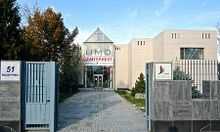
Educational institutions in Bishkek include:
- American University of Central Asia
- Arabaev Kyrgyz State University[27]
- Bishkek Humanities University
- International Ataturk-Alatoo University[28]
- International University Of Kyrgyzstan[29]
- Kyrgyz Russian Slavonic University[30]
- Kyrgyz State Medical Academy
- Kyrgyz State National University[31]
- Kyrgyz Technical University
- Kyrgyz-Russian State University
- Kyrgyz-Turkish MANAS University[32]
- Kyrgyz Uzbek University
- Plato University of Management and Design[33]
In addition, the following international schools serve the expatriate community in Bishkek:
- European School in Central Asia[34]
- Hope Academy of Bishkek[35]
- QSI International School of Bishkek[36]
- Silk Road International School[37]
Transportation
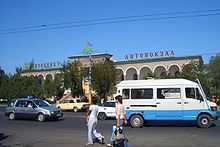
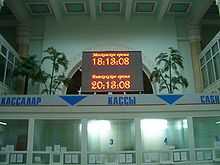

Mass public transport
There is public transportation available, including buses, electric trolley buses, and public vans (known in Russian as marshrutka). The first bus and trolley bus services in Bishkek were introduced in 1934 and 1951 correspondingly. [38]
Taxi cabs can be found throughout the city.
There is no subway in Bishkek, but the city is considering designing and building a light rail system (Бишкекское лёгкое метро).
Commuter and long-distance buses
There are two main bus stations in Bishkek. The smaller old Eastern Bus Station is primarily the terminal for minibuses to various destinations within or just beyond the eastern suburbs, such as Kant, Tokmok, Kemin, Issyk Ata, or the Korday border crossing.
Long-distance regular bus and minibus services to all parts of the country, as well as to Almaty (the largest city in neighboring Kazakhstan) and Kashgar, China, run mostly from the newer grand Western Bus Station; only a smaller minority of them runs from the Eastern Station.
The Dordoy Bazaar on the north-eastern outskirts of the city also contains makeshift terminals for frequent minibuses to suburban towns in all directions (from Sokuluk in the west to Tokmak in the east) and to some buses taking traders to Kazakhstan and Siberia.
Rail
As of 2007, the Bishkek railway station sees only a few trains a day. It offers a popular three-day train service from Bishkek to Moscow.
There are also long-distance trains that leave for Siberia (Novosibirsk and Novokuznetsk), via Almaty, over the Turksib route, and to Yekaterinburg (Sverdlovsk) in the Urals, via Astana. These services are remarkably slow (over 48 hours to Yekaterinburg), due to long stops at the border and the indirect route (the trains first have to go west for more than a 100 kilometres (62 mi) before they enter the main Turksib line and can continue to the east or north). For example, as of the fall of 2008, train No. 305 Bishkek-Yekaterinburg was scheduled to take 11 hours to reach the Shu junction—a distance of some 269 kilometres (167 mi) by rail, and less than half of that by road.[39]
Air
The city is served by Manas International Airport (IATA code FRU), located approximately 25 kilometres (16 mi) northwest of the city centre, and readily reachable by taxi.
In 2002, the United States obtained the right to use Manas International Airport as an air base for its military operations in Afghanistan and Iraq. Russia subsequently (2003) established an air base of its own (Kant Air Base) near Kant some 20 kilometres (12 mi) east of Bishkek. It is based at a facility that used to be home to a major Soviet military pilot training school; one of its students, Hosni Mubarak, later became president of Egypt.
Notable people
- Roza Isakovna Otunbayeva (23 August 1950 -) - Third President Of Kyrgyzstan.
- Chingiz Aitmatov
Sister cities
Sister cities of Bishkek include:
 Almaty, Kazakhstan
Almaty, Kazakhstan Astana, Kazakhstan
Astana, Kazakhstan Qazvin, Iran
Qazvin, Iran Colorado Springs, Colorado, United States, since 1994
Colorado Springs, Colorado, United States, since 1994 Meriden, Connecticut, USA, since 2005
Meriden, Connecticut, USA, since 2005 Ankara, Turkey
Ankara, Turkey İzmir, Turkey
İzmir, Turkey Ürümqi, People's Republic of China
Ürümqi, People's Republic of China Minsk, Belarus, since 2008[40]
Minsk, Belarus, since 2008[40]
References
- ↑ Law on the Status of Bishkek, 16 April 1994, article 2 (Russian). Retrieved on 3 August 2009
- ↑ Districts of Bishkek (Russian). Retrieved on 3 August 2009
- ↑ 3.0 3.1 Statoids. Statoids. Retrieved on 11 March 2012.
- ↑ Residential Real Estate Market in Bishkek, Kyrgyzstan: Current Conditions and Prospects
- ↑ Catholic Church in Kyrgyzstan. Catholic-kyrgyzstan.org. Retrieved 11 March 2012.
- ↑ "Koppen Map". Upload.wikimedia.org. Retrieved 21 November 2012.
- ↑ 7.0 7.1 "Weather and Climate-The Climate of Bishkek" (in Russian). Weather and Climate. Retrieved 14 August 2012.
- ↑ "World Weather Information Service – Bishkek". World Meteorological Organisation (United Nations). Retrieved 14 August 2012.
- ↑ "Climatological Normals of Bishkek". Hong Kong Observatory. Retrieved 14 August 2012.
- ↑ Первая всеобщая перепись населения Российской Империи 1897 г. Наличное население в губерниях, уездах, городах Российской Империи (без Финляндии). Семиреченская область - First General Russian Empire Census of 1897. Population in provinces, districts, towns of Russian Empire (without Finland). Semirech'e Province (Demoscope.ru) (Russian)
- ↑ Petrov, Vladimir (2005). Пишпек исчезающий 1825–1926 (Pishpek disappearing. 1825–1926). Bishkek
- ↑ Pisarskoy, Evgeniy; Kurbatov, Valentin (1976). Архитектура Советской Киргизии (Architecture of Soviet Kirghizia.). Moscow: Stroyizdat
- ↑ Review of Semirech'e Oblast for 1907 (Обзор Семиреченской области за 1907 год). Verniy: Publishing House of Semirech'e Provincial Administration. 1908
- ↑ Review of Semirech'e Oblast for 1902 (Обзор Семиреченской области за 1902 год). Verniy: Publishing House of Semirech'e Provincial Administration. 1903
- ↑ Всесоюзная перепись населения 1926 года : Киргизская АССР. (All-Union Census of 1926: Kyrgyz ASSR). Moscow: CSU SSSR. 1928
- ↑ Численность наличного населения городов, поселков городского типа, районов и районных центров СССР по данным переписи на 15 января 1970 года по республикам, краям и областям (кроме РСФСР). Demoscope.ru. Retrieved on 11 March 2012.
- ↑ "Население Кыргызстана | Перепись населения и жилищного фонда Кыргызской Республики 2009". 212.42.101.100:8088. Retrieved 21 November 2012.
- ↑ 18.0 18.1 "Анализ загрязнения атмосферы". Nature.kg. Retrieved 21 November 2012.
- ↑ Web-site of the State Agency on Environment Protection and Forestry: Assessment of Air Pollution. Meteo.ktnet.kg. Retrieved on 11 March 2012.
- ↑ "New mayor of Bishkek promises to solve capital’s problems". The Times of Central Asia. 17 October 2007. Archived from the original on 24 October 2007. Retrieved 18 October 2007.
- ↑ Marat, Erica (15 October 2007). "Upcoming referendum sinks Kyrgyzstan deeper into crisis". Eurasia Daily Monitor (The Jamestown Foundation) 4 (190). Archived from the original on 22 October 2007. Retrieved 18 October 2007.
- ↑ "Kyrgyz capital gets new mayor". Radio Free Europe. 22 August 2005. Archived from the original on 18 November 2010. Retrieved 18 October 2007.
- ↑ "New Mayor for Bishkek". Lenta.Ru. 7 July 2008. Archived from the original on 18 November 2010. Retrieved 25 September 2008.
- ↑ Corporate Japanese companies to renovate Kyrgyzstan football stadium. The-afc.com (9 November 2007). Retrieved on 11 March 2012.
- ↑ Federation of International Bandy-About-About FIB-National Federations-Krygyzstan. Internationalbandy.com. Retrieved on 11 March 2012.
- ↑ Federation of International Bandy-Olympic. Internationalbandy.com (12 August 2004). Retrieved on 11 March 2012.
- ↑ October 2009+01:35:14
- ↑ "International Ataturk Alatoo University". Iaau.edu.kg. Retrieved 21 November 2012.
- ↑ "Главная Международный университет Кыргызстана.|". Iuk.kg. Retrieved 21 November 2012.
- ↑ "Кыргызско-Российский Славянский университет имени Б.Н. Ельцина - Главная". Krsu.edu.kg. Retrieved 21 November 2012.
- ↑ "Новости КНУ им. Ж.Баласагына". University.kg. 1 November 2012. Retrieved 21 November 2012.
- ↑ "Kırgızistan-Türkiye Manas Üniversitesi". Manas.kg. Retrieved 21 November 2012.
- ↑ "Plato UMD - Home". Umd.edu.kg. Retrieved 21 November 2012.
- ↑ "European School in Central Asia - Bishkek - Kyrgyzstan". Europeanschool.kg. 1 September 2011. Retrieved 21 November 2012.
- ↑ "Hope Academy of Bishkek". Hopeacademykg.com. Retrieved 21 November 2012.
- ↑ "Welcome | QSI". Bishkek.qsischool.org. Retrieved 21 November 2012.
- ↑ "SRIS". SRIS. Retrieved 21 November 2012.
- ↑ "Frunze. City Encyclopedia.". Retrieved 2014-01-26.
- ↑ "Маршрут поезда ????? - ????? на сайте". Poezda.net. Retrieved 21 November 2012.
- ↑ "Twin towns and Sister cities of Minsk [via WaybackMachine.com]" (in Russian). The department of protocol and international relations of Minsk City Executive Committee. Archived from the original on 2 May 2013. Retrieved 21 July 2013.
Since 23 May 1994 Tehran and Bishkek are twinned cities as well.
External links
| Wikimedia Commons has media related to Bishkek. |
| Wikivoyage has a travel guide for Bishkek. |
| |||||||||||||||||||||||||||||
| |||||||||
| |||||||||
| ||||||||||||||||||||||
Coordinates: 42°52′29″N 74°36′44″E / 42.87472°N 74.61222°E



